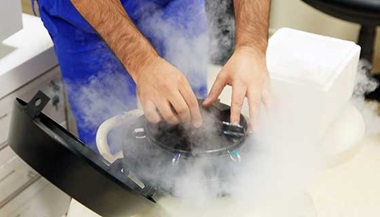Fertility and Pregnancy After a LEEP
Reviewed By:
It’s natural for women who are considering the loop electrosurgical excision procedure (LEEP) to be worried about the impact on their fertility and future pregnancies. This common method of removing abnormal cells from the cervix to prevent cancer does carry some risks, although they’re rare, says Dana Baras, M.D., M.P.H., a Gyn/Ob at Howard County General Hospital.
Wondering if you’ll have difficulty starting or growing your family because you’ve had a LEEP? Most women have no cause for concern, says Baras, who addresses the top questions women have about fertility and pregnancy problems after a LEEP.
Can you get pregnant after a LEEP?
There’s a small risk of scar tissue forming over the cervical opening (called cervical stenosis) after a LEEP. If the cervical passageway is narrowed or closed, this can cause irregular or absent periods or prevent sperm from getting through the cervix into the uterus to fertilize an egg. Cervical stenosis occurs rarely, although it’s more likely to happen if a greater amount of tissue needs to be removed during the procedure, or if you’ve had more than one LEEP.
After diagnostic tests such as colposcopy (in which a special microscope is used to view the cervix with a green filter light, allowing the doctor to look for changes and take a biopsy), your Gyn/Ob will determine how much tissue needs to be removed. This depends on where the abnormal cells are located.
When can you start trying to conceive after a LEEP?
Immediate recovery takes about two weeks. We recommend that women avoid sex or inserting anything into the vagina for four weeks. Full recovery of the cervix takes about six months. I usually tell my patients who have no evidence of cervical cancer to wait six months before trying to conceive.
How do you know the LEEP was effective?
To ensure that the abnormal cells have cleared, we recommend seeing your Gyn/Ob for a follow-up exam. Depending on the results of the pathology report, a patient may need additional testing such as a repeat Pap test, HPV testing, endocervical curettage (a type of biopsy inside the cervix) or even a hysterectomy.
About LEEP

LEEP is used to diagnose and treat abnormal or cancerous conditions in a woman's lower genital tract. Learn how the procedure is performed and the best ways to ease recovery.
Can the LEEP affect pregnancy?
If your doctor discovers high-grade abnormal cells during pregnancy, you’ll have to wait until after giving birth to have the LEEP performed. Having a LEEP prior to pregnancy doesn’t increase the likelihood of miscarriage. The procedure can cause difficulty in the early stages of labor for a small number of women who develop cervical stenosis. Women with this condition can take longer to dilate than average, but a Gyn/Ob can use various methods to help stretch the cervix.
In the past, doctors would check the length of the cervix in women who’ve had a LEEP. That’s because they’re more likely to have a shortened cervix, which doctors thought could affect the ability of the cervix to stay closed during pregnancy, thus leading to preterm birth. However, recent studies indicate that cervical dysplasia — abnormal (precancerous) cells in the cervix caused by HPV — and other risk factors such as smoking are more strongly linked with preterm birth than the LEEP itself.
The bottom line
The LEEP is a safe and effective way to remove abnormal cells from the cervix, which could turn into cancer. There is rarely an impact on fertility and pregnancy after a LEEP. But you should always discuss any concerns you have with your doctor.







